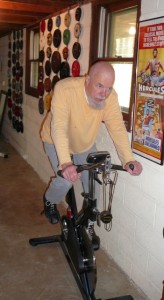30 Jul Senior health: Exercise tips for older adults

People of just about any age can benefit from exercise.
Senior citizens who exercise can gain more muscle tone and strengthen bones. They can actually gain more confidence in their everyday life.
People of just about any age can benefit from exercise.
Senior citizens who exercise can gain more muscle tone and strengthen bones. They can actually gain more confidence in their everyday life.
Even walking or light exercise can help improve the quality of life.
Exercise by seniors can prevent or delay diseases such as heart disease, diabetes and osteoporosis. It has also been found to improve mood and reduce depression.
Here are some tips for seniors on how to go about exercising:
* Do things you like, such as taking a brisk walk outside or on a treadmill, swimming, riding a bike or dancing.
* Working around the house or in the garden at a brisk pace is exercise, too. Stay active any way you can.
* Try to build up your endurance to the point where you can do an activity, such as walking or riding a bike, for 30 minutes if possible.
You don’t have to do it all at once – you can walk or ride for 10 minutes, take a break and then go again.
* Know your limits. If you can carry on a conversation without any trouble, you are not working hard enough. If you can’t talk at all, it’s too hard. Strive for something in the middle.
* Make sure to do strength training exercises, which can help you avoid falls. Use a functional trainer or light free weights.
* Work on your balance, such as standing on one foot and then the other. Use a table or counter to help balance if you need to.
* If you haven’t been real active, start out slowly. Consult a doctor before beginning any new exercise program.
* Remember to keep good posture, lift with the legs and not the back. Bend forward from the hips, not the waist.
* Warm up your muscles BEFORE stretching. Examples: Take a light walk and lightly pump the arms at the same time to get the blood flowing, or ride an exercise bike.
* Exercise should get you breathing a little bit hard, but shouldn’t hurt or make you feel really fatigued. Expect to feel some soreness, but stop if you feel sharp pain.
In the long run, exercise doesn’t hurt – it actually should make you feel better throughout your everyday life.
At Home Fitness consultant Aaron Dorksen’s blog deals with a variety of fitness topics, ranging from workout tips, motivational ideas and feature stories on how exercise impacts people’s lives. E-mail him with comments, questions or ideas for future blogs at aaron@athomefitness.com

